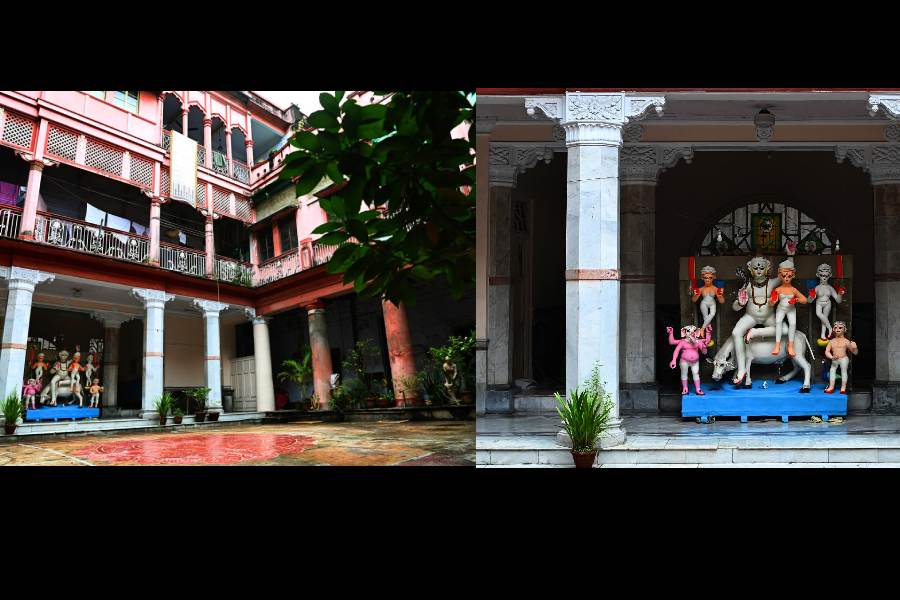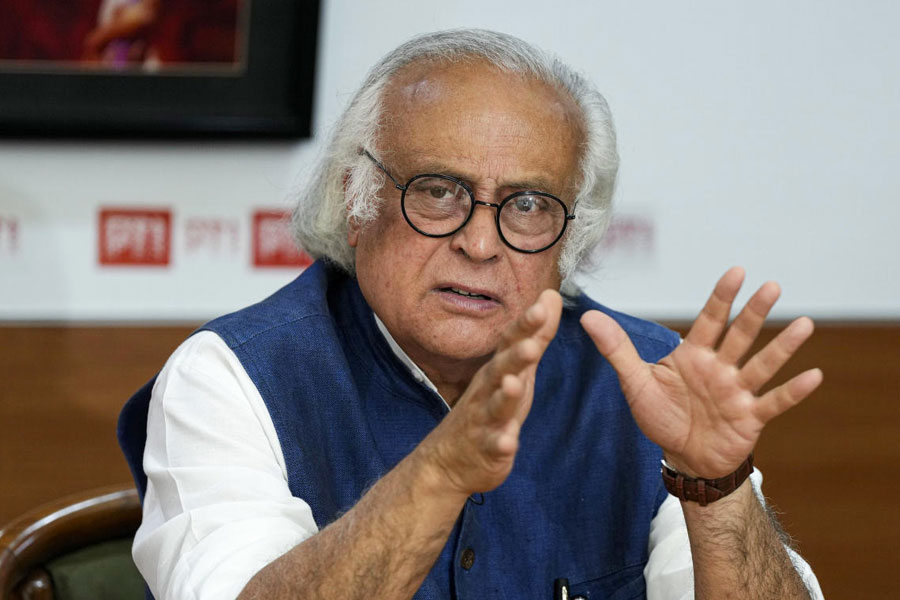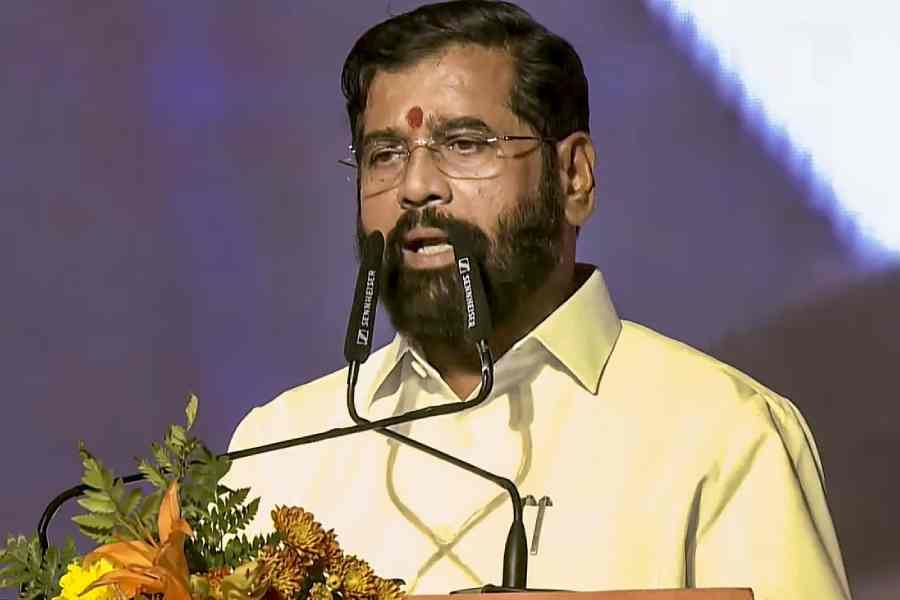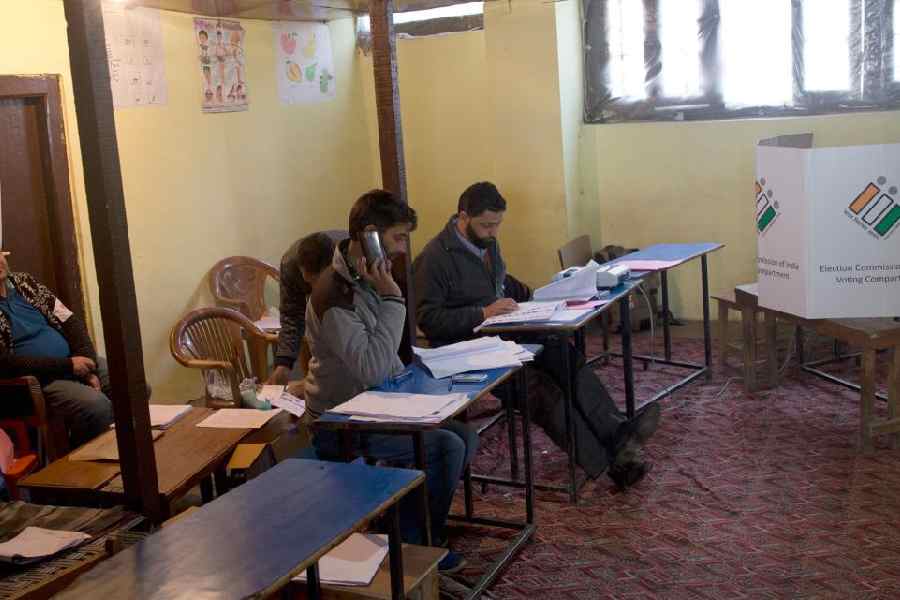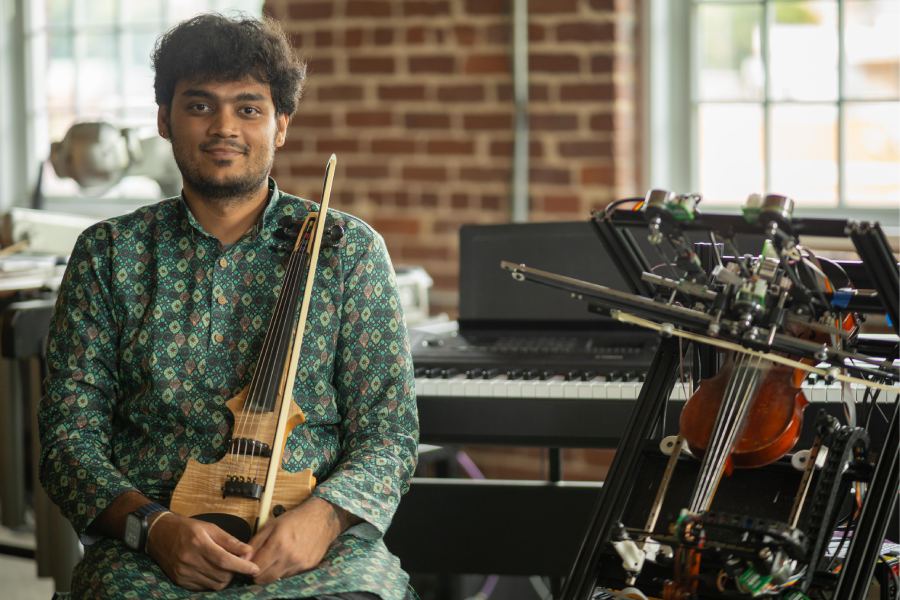If you’re tired of visiting the same old heritage properties in the city during Durga Puja, this year you can try out some remarkable spots in the heart of the city that have been preserving the festival’s traditions for over two centuries. These palatial houses or bonedi baris have their roots stuck in the city even before Calcutta came into existence. For centuries, Calcutta’s palatial houses have welcomed Goddess Durga as their own daughter, embodying tradition and devotion passed down from generation to generation. From welcoming Goddess Durga to bidding her farewell with tearful eyes, each ritual has been performed in different ways in each of these houses. Visiting these places allows you to experience the essence of Calcutta’s Durga Puja, rooted in tradition and community spirit, far from the modernised celebrations. t2 explored three such addresses where the grandeur of Durga Puja is intertwined with history and culture.
BHOLANATH DHAM (MANIKTALA)
Nestled quietly in the heart of Goa Bagan, Maniktala, Bholanath Dham is a humble abode of the Dutt family. This residential house came into existence when Raghunath Dutt purchased the property in 1922. Before that, the Dutt family was deeply involved in the grand celebration of Kali Puja at their ancestral house in Sovabazar, which had been a tradition since 1875. While Kali Puja had long been celebrated, the family aspired to expand their festivities to include Durga Puja as well. However, the Sovabazar house lacked the space required for such a large celebration, prompting Raghunath Dutt to make significant architectural changes to their new property in Maniktala.
Determined to celebrate Durga Puja on a grand scale, Raghunath transformed the courtyard of their new home into a spacious 1,300sq ft thakurdalan. After three years of extensive renovations, Bholanath Dham was ready to host its first Durga Puja in 1925. Since then, the tradition has continued and the Dham is now approaching its 120th anniversary, making it an integral part of Calcutta’s cultural and religious history.
One of the unique features of Bholanath Dham’s Durga Puja is the idol itself. Unlike the conventional Durga idols seen across the city, Bholanath Dham worships a distinctive Shibo-Durga murti, a sculpture where Durga is depicted sitting on the lap of her husband, Shiva. The idol is crafted with great care and precision by the renowned artisans of Surendranath Pal and Sons, right in the front yard of the house. In this portrayal, Durga is seen not just as a powerful Goddess but as a daughter returning to her maternal home, accompanied by her husband and four children. Shiva, as the son-in-law, is treated with great respect, a reflection of the family’s devotion to both Durga and Shiva. In the four days, Shiva is given the perfect jamai aador a son-in-law gets in a Bengali family. Day and night, Durga, Shiva and their four children are treated with luchi, cut fruits, sweets and loads of love.
The Dutt family’s deep connection to Lord Shiva is also the reason why the house is named Bholanath Dham, as Shiva is often referred to as Bholanath. The entire celebration is infused with familial warmth, as Durga is welcomed not just as a Goddess but as a beloved daughter returning home. The symbolism of this relationship is at the core of the festival at Bholanath Dham.
Traditions at Bholanath Dham extend beyond the worship of the idol. One of the most remarkable rituals is the Dhuno Purana, a centuries-old tradition that involves a woman from the family dressed in a wet cotton sari, balancing three earthen bowls, or malshas, on her head and hands. These bowls are filled with a mixture of jute sticks and dhuno, which are set alight, creating a crackling fire that symbolises purification and devotion. The ritual is a dramatic and sacred spectacle, deeply rooted in the family’s beliefs.
Adding to the spiritual ambience is the sound of the dhaak. At Bholanath Dham, the dhaak has been played by three generations of the same dhaaki family, a continuation of their age-old association with the Dutt family. The deep, resonant beats of the dhaak reverberate through the thakurdalan, marking the joyous and solemn moments of the Durga Puja.
For the Dutt family, the Durga Puja at Bholanath Dham is not just a religious festival but a celebration of their heritage, traditions and devotion. Their belief in the divine protection of the Gods has been unwavering and as the Dham approaches its 120th year, it stands as a symbol of faith, family and cultural continuity in Calcutta.
RAMGOPAL SAHA HOUSE (BOWBAZAR)
In central Calcutta, we stumbled upon a hidden gem of history, culture, and tradition — the 193-year-old Ramgopal Saha House. For those looking to immerse themselves in the true essence of a bonedi bari Puja or capture the perfect festive photographs, this iconic house is the ideal destination. Upon entering through the heavy iron gates, your eyes are immediately drawn to the intricately embroidered arches in gold, white, and green, with the red thakurdalan standing in all its grandeur. The thakurdalan, measuring an impressive 1,000sq ft, exudes a sense of timeless beauty and reverence.
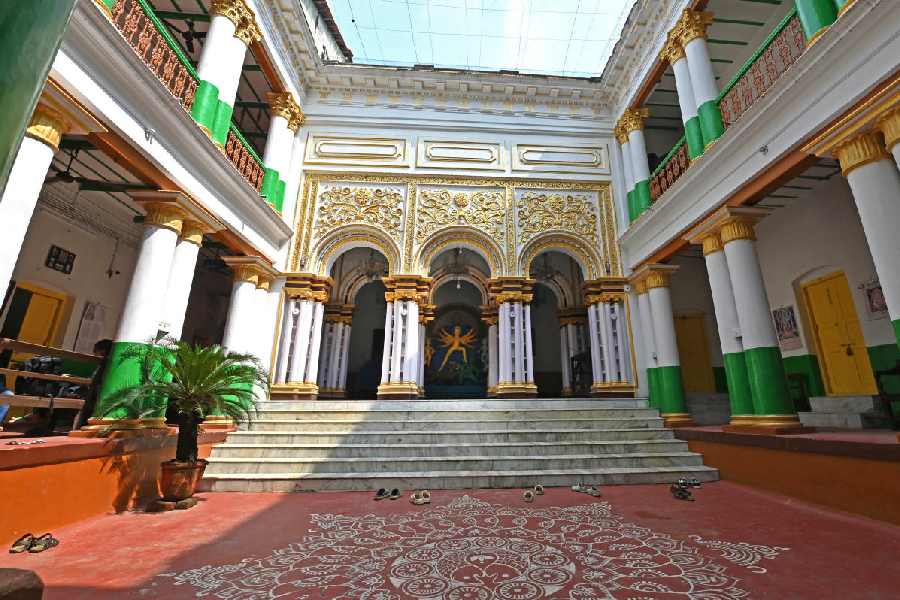
The traditional thakurdalan at Ramgopal Saha House is adorned with alpona on the red floor.
After a short ascent via a flight of steps, you’ll find the magnificent Goddess Durga, adorned with her four children — Lakshmi, Saraswati, Ganesha, and Kartik.
This house holds more than just architectural beauty — it is steeped in tradition and legacy. Ramgopal Saha, a businessman, started the Durga Puja celebrations here 173 years ago and the family has meticulously preserved every ritual since. The customs, right from carrying Goddess Durga on the family members’ shoulders to Babu Ghat for immersion, to bringing in the same family of purohits (priests) for generations, are all performed with the same devotion as their ancestors once did.
One of the most mesmerising aspects of this house during Durga Puja is the 20x8 ft idol of Goddess Durga and her children, all draped in the exquisite white daaker saaj —an intricate decoration made from pith. Another striking feature is the adornment of Durga, Saraswati and Lakshmi with pure gold nose hoops (nath), purchased annually from the historic shop, Prasanta Dutta and Sons. A unique tradition of the Saha family is that these gold nose hoops are immersed along with the idols every year! Durga’s majestic lion is also bedecked with a family heirloom — a guinea chain from the Elizabethan era that has been passed down through generations. Additionally, the Gods and Goddesses are equipped with silver weapons, adding a touch of elegance and grace to the grandeur of the idol.
The dhaakis at Ramgopal Saha House come from Burdwan, where they belong to a family of dhaakis who have served the house for years. Their rhythmic beats add to the authentic feel of an Ashtami night, especially during the shondhi pujo — a magical ritual performed during Ashtami.

The huge arches complimented by the warm light of the German glass chandeliers are the perfect backdrop for your Puja special click.
Another notable aspect of the Saha family’s Durga Puja is the daily bhog prepared for Goddess Durga and her children. The food is cooked in traditional wood fire, preserving the authenticity of the rituals. During Durga Puja, the entire house transforms into a traditional bonedi bari, with German glass chandeliers casting a soft glow and velvet curtains adorning the verandahs, recreating the aura of a bygone era when British officials frequented the house.
The Saha family views the property as ‘Ma’r Bari’ (Mother’s house), meaning it is open to all during the festivities, welcoming visitors to experience a piece of history and the rich traditions of Bengal’s Durga Puja.
HARAKUTIRRAY-BANERJEE BARI (MALAPARA)
Nestled in the historic lanes of north Calcutta, Harakutir Ray-Banerjee Bari stands as a witness to centuries of history. Built on what was once a crematorium ground along the banks of the Ganga, this house is 271 years old, but its history stretches back even further. Durga Puja this year in this house is completing 332 years, starting in the late 1690s when the house was little more than a hut. For those with a deep appreciation of history or a passion for unravelling mysteries, Harakutir is a treasure trove of stories, enhanced by its grand annual Durga Puja.
Over the centuries, Harakutir has been a silent spectator to Bengal’s most pivotal moments. Its walls hold secrets from the time of the freedom struggle, with hidden tunnels that sheltered famous Bengali revolutionaries. The house was apparently even graced by Netaji Subhas Chandra Bose during India’s fight for Independence. In one of the many rooms, Bankim Chandra Bandyopadhyay is said to have penned India’s national song, Vande Mataram. Moreover, Mahnayak Uttam Kumar found solace within the house, often visiting his maternal sister who lived there, enjoying some dim-er devil while soaking in the historic ambience.

Harakutir Ray-Banerjee Bari gets ready for Durga Puja.
The roots of the Banerjee family’s Durga Puja go back almost two centuries when the family patriarch, Kirti Chandra Bandyopadhyay, had a divine dream of worshipping Goddess Durga in their front yard. Today, that front yard is a 1,750sq ft thakurdalan, where the festivities continue with fervour. The house itself, with its neo-classical architecture, stands as a relic of the past, showcasing the grandeur of a bygone era.Durga Puja at Harakutir is a 10-day affair, with preparations officially beginning the day after Janmashtami. The idol of Goddess Durga, standing 7.5X6ft tall, was first adorned by the renowned artist Bhootnath Malakar in a traditional decoration made using intricate designs of buttons and finger rings. Over the years, the design of the idol has evolved, often reflecting miraculous events that have occurred in the family, making each year’s idol different.
During the four main days of Durga Puja, the Banerjee family adheres to a strict vegetarian diet, with the male members of the household taking on the responsibility of cooking the traditional bhog. Interestingly, the local sweet makers, or moiras, also take shelter in the house during the festival, preparing mouthwatering Bengali sweets like mishti doi, pantua, and rosogolla for everyone to enjoy. It’s only on the day of bidding farewell to Goddess Durga, during the immersion, that the family partakes in fish, which is considered auspicious. A unique rule the family strictly follows is that the immersion of the Goddess must be completed before the sun sets.
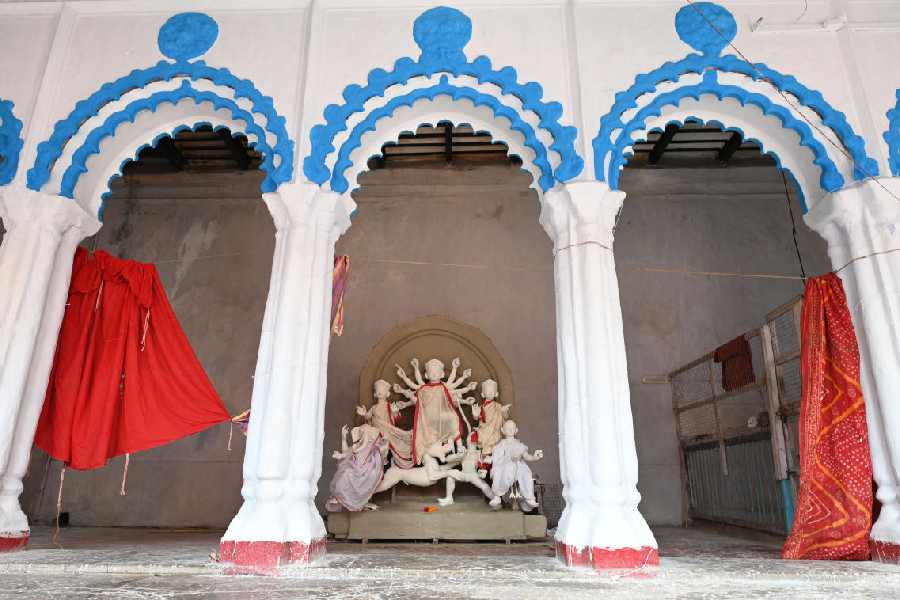
The idol in the making.
The grandeur and historic significance of this Durga Puja make it a must-visit for those seeking to experience the festival with a deep connection to Bengal’s past.For those in search of a Durga Puja steeped in history, Harakutir Ray-Banerjee Bari is the perfect destination, offering not only the spiritual fervour of the festival but also a rich tapestry of stories that bring Bengal’s cultural and historical legacy to life.

